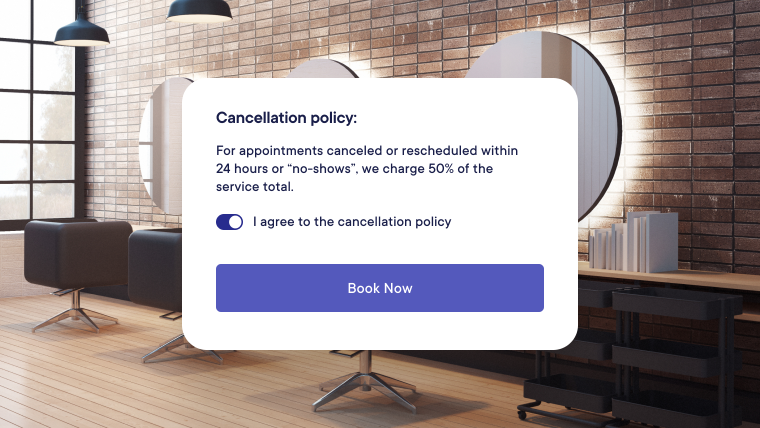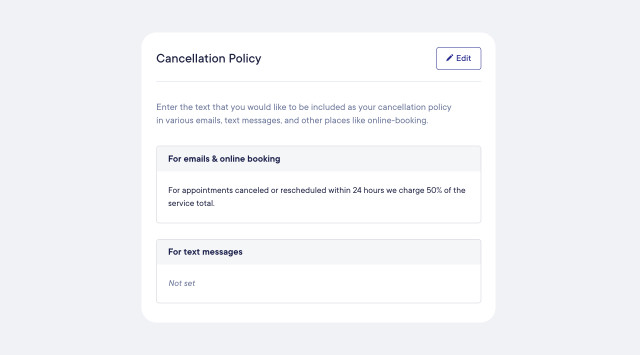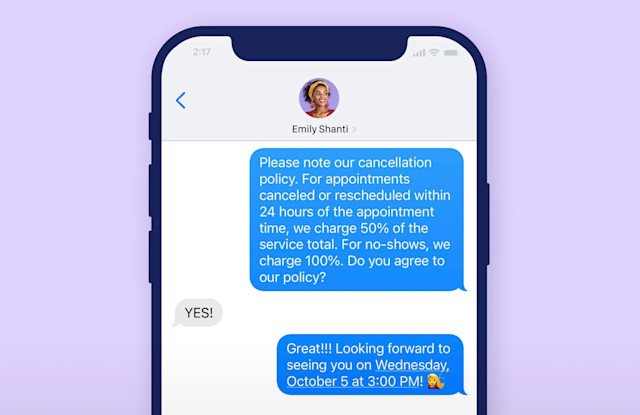
How your old salon cancellation policy may actually be hurting your business
We sat down with beauty business guru Stephanie Mitchell to talk boundaries and how to take the awkward out of enforcing your spa or salon cancellation policy.

Content Marketing Manager
Let’s talk about boundaries.
Like any big endeavor, running a salon or spa comes with its fair share of difficult decisions and uncomfortable conversations. From policies to professional etiquette, setting boundaries seems obvious…until it isn’t. That is, it’s easy to talk a big game about where you draw the line but, when it comes time to put your foot down, it’s not always so cut and dry.
Mangomint’s Vice President of Sales Marchelle McKeirnan recently sat down with our good friend and beauty business guru Stephanie Mitchell to tackle challenges beauty and wellness business owners face on a daily basis. In their two-part conversation, they demystify some of the most contentious aspects of establishing boundaries with clients and share tried-and-true advice from their years in salon ownership, management, and marketing.
In Part 1 of this two-part series on establishing boundaries in the salon or spa, we discuss the dreaded cancellation policy. This week, Stephanie and Marchelle break down how you can make this strategic business tool work to your advantage by hitting the three Cs: Culture, communication, and commitment.
Culture: Making Your Policy Fit Your Vibe
A cancellation policy can represent many things. But, most of all, it should represent you.
Do you have to have a cancellation policy?
Not all salons and spas have a cancellation policy. In fact, some very successful ones don’t. But there’s a good reason why most business owners opt to create one.
A cancellation policy allows owners to set expectations with their clientele and safeguard their income as well as that of their stylists.
“When I first started my career, I specialized [in] haircuts only,” says Marchelle, reflecting on her early days behind the chair. “But I remember watching the colorists who would have a color makeover on their day that would no-show. And that would just kill a four, four-and-a-half, or five-hour chunk of their day.”
Long-time beauty professionals can vouch: Enforceable cancellation policies in the salon and spa world are relatively new. Sure, back in the day you could have your policy posted all around your space (to mixed effect). But until recently, most salons and spas simply didn’t have access to affordable tools to allow for a credit card to easily be stored on file or compensation to actually be made for a beauty professional’s time.
Your culture should inform your cancellation policy
From the duration and price of your services to the decor and theme of your space, your unique salon or spa culture shapes how your clients perceive your business and how to behave there. That’s why, when deciding on your cancellation policy, your culture is your guiding light.
To start, your cancellation policy should always reflect the importance of what canceling means to you.
The question you want to ask yourself is: By a client not showing up to their service, how much time and money do you or your stylists or service providers stand to lose?
Here are some situations where a cancellation or no-show might hurt extra bad:
You offer time-intensive (and expensive), multi-process services that take a half- or whole-day.
You do extensions that require you to order several hundred (or several thousand) dollars worth of hair, and could take days or weeks of shipping time.
You have a long waitlist of people waiting to get on your books, and a no-show is a missed opportunity for someone else to take that slot.
“Your cancellation policy should reflect that,” says Marchelle.
If you’ve been in any one of these situations, you know that even just one no-show or last-minute cancellation in a week can translate directly to hours and pay lost.
Cancellation policies help curb your losses by serving as an important filter for clients who will try their best to avoid these problems for you and themselves.
“For the business that doesn’t want to hold cards on file, they have to recognize that they’re inevitably going to have the customers that chose not to go to a salon that does have a strict cancellation policy,” says Marchelle about this filter. “So, this goes back to your ICP [ideal customer profile]. Who is your ideal profile that you’re serving? And is that someone who respects cancellation policies and boundaries?”
This strikes at the very heart of your culture and its necessary support systems: Who are the kinds of clients you want to attract and serve? Do they respect your time, policies, and boundaries? Do they understand what your time and services are worth?

Need help overhauling your cancellation policy? Check out our Salon Cancellation Policy Guide.
Communication: Getting Clients to Agree to Your Policy
Just like a bad relationship, listening isn't the same as hearing.
Displaying your policy isn’t enough
Cancellation policies can sometimes get the side-eye from clients. (It’s not just you!) So, it’s understandable that many business owners want to shortcut the communication process by printing out their cancellation policy and posting it all around the salon, taped to every mirror or framed at the front desk as a warning to the would-be appointment-canceller.
But, more often than not, this approach fails to meaningfully reduce no-shows and last-minute cancellations. Because, realistically, why would it?
Perhaps the most important issue with this approach is that it’s inherently passive. There’s no guarantee that clients will read your policy, no less agree to it, because they aren’t required to. As Marchelle points out, your policy should require acknowledgment and action on the part of the client to accept it.
She says the key to reducing the frequency of cancellations is “communicating [the policy] and having it set up to where they have to acknowledge it at some point.” She continues, “The communication needs to be upfront…And it needs to be in a way where we can say, ‘This is what I sent you, this is what you agreed to.’ It has to be written. It has to be clear. It has to be concise.”
How to effectively communicate your cancellation policy
How you communicate your cancellation policy lays the groundwork for a productive and mutually respectful relationship between you and your client—neither should waste time and money bickering over poorly communicated or acknowledged boundaries.
Regardless of the medium you use to interface with your clientele, it’s important to ensure that each and every client agrees to your policies before booking an appointment. Some methods are more capable than others in accomplishing this task.
The Phone Call
When booking over the phone on a busy day, just getting a new client’s info down is a challenge, let alone explaining extra details like your parking situation, health and safety protocols (thanks, COVID!), or your cancellation policy.
And while you should disclose your policy, verbally explaining it over the phone isn’t the same as gaining acknowledgment. Unless you’re using salon and spa software that requires the client to agree before booking an appointment, it’s nearly impossible to guarantee your client has agreed to your policy in any meaningful capacity that you can reference later.
Messaging
A large percentage of today’s beauty professionals and salon and spa owners communicate with new and existing clients primarily through text or messaging apps like Instagram, Messenger, TikTok, or WhatsApp.
While ease of access is its primary draw, this method also offers the benefit of creating consistency in how you communicate your cancellation policy.
“I’m a huge proponent of just having scripts, or what I call ‘snippets,’” says Marchelle. In the back and forth of a messaging-based booking process, these pre-written text snippets are great for confirming that your client has received and acknowledged your cancellation policy while still “having fun ways of interacting with the customer so it’s not just like this dry reading [of the policy].”

Whether you’re using Meta Business Suite or another app, have your cancellation policy saved in a snippet and ready to send over. And make sure that your policy includes language that requires the client to respond “Yes” or “I agree” to verify acknowledgment before booking their appointment.
Getting those receipts will be a lifesaver later in enforcing your policy, should that situation arise.
Salon and Spa Management Software
While the solopreneur may be able to get by communicating directly with clients via messaging alone, salons and spas with busy front desks and multiple stylists, massage therapists, nail techs, or estheticians usually require more efficient options to communicate important information with their larger clientele.
In the past decade alone, the rise of smartphones and mobile apps has driven some of the greatest advancements in salon and spa software that the industry has ever seen. Every year, thousands of business owners are ditching their paper books and credit card terminals for modern software with convenient features like online booking, smart waitlists, automated appointment confirmations and reminders, and integrated payment processing.
And when it comes to communicating your cancellation policy, the right software can also help take the awkward out of the equation.
For instance, with Mangomint, your clients can easily book online or over the phone and accept your cancellation policy during the process. Unlike standard phone calls, Mangomint’s Express Booking only requires you to get your client’s name and phone number, after which the software will text the client a link to where they can fill out the rest of their information and—you guessed it!—accept your cancellation policy.
“They actually have to select, with their own hand, a toggle that says ‘I agree to this policy,’” explains Marchelle, highlighting how Mangomint ensures that a client can’t miss or ignore your boundaries before booking with you. “Same thing with notifications: In Mangomint, all of our notifications are going to have your cancellation policy.”
To learn more about Express Booking, check out our guide here
Commitment: Enforcing Your Cancellation Policy
Committing to your policy is just as much about separating yourself from your business as it is about protecting your income.
Reflect your culture even when your policy has been violated
So, you’ve written a cancellation policy that reflects your culture and found an effective way to communicate it to your clients. Now comes the hard part: Sticking to it.
Enforcing your cancellation policy can be a challenge, especially if it isn’t well communicated, and even more so if you are a solopreneur or a new stylist. Just as your culture should be embodied in your cancellation policy, it should also guide how you enforce it.
As frustrating as it can be to deal with a no-show (and how awkward it can be to charge the fee), approaching the situation with grace goes a long way towards softening the blow, strengthening that relationship, and preventing similar issues in the long run.
Marchelle recommends enforcing your policy in a way that represents who you are. After a no-show, she, for instance, liked to send gentle reminders to her clients – not just about the fee being charged but also to convey that she cared about them and whatever prevented them from making their appointment.
“I personally always reached out again. That was just part of my culture,” she says. “I sent them a really nice note [saying,] ‘Hey, just want to make sure everything's OK.’ Because we don't know what's going on, something terrible might have happened. So, I think it's important to reiterate the policy and just send them a little note: ‘You will be charged for this. If I'm missing anything, please let me know.’”
While you can customize your enforcement message for each client and the occasion, it’s smart to have a pre-written snippet on hand, especially if writing out those messages in the moment makes you feel anxious, nervous, or guilty. This way, you’ve already done all the hard work to prepare for this moment, and it’s just about sticking the landing with confidence.
With that being said, make sure that your message is appropriate, respectful, and kind in case the client is going through something that is totally sudden, unexpected, or out of their control. Be mindful of the possibilities, and focus on showing them that you care while also reinforcing your boundaries with respect to your business.
The Thing About Deposits
Finally, let’s get into the weird world of deposits.
Whether you love them or hate them, deposits do function as a sort of insurance policy for your business, especially if you specialize in big-ticket services that block out a significant chunk of your time or demand a lot of overhead (e.g., hair extensions, color corrections, full lash sets, permanent makeup, wig installations).
With that being said, a deposit can be a double-edged sword if you don’t clearly establish what that upfront fee is for.
In the hair world, specifically, deposits are typically attributed toward the total cost of the service, which leaves the fate of that deposit up in the air. Marchelle says it’s then up to the business owner to decide: “Are deposits refundable or not? Do deposits move with the appointment [date] or not? What is the deposit actually for? Is it for reserving time on the calendar, or is it a portion of the payment towards the service that they have not had rendered? These things all matter when you go to the bank because somebody disputes the $50 deposit.”
That is, if you put the deposit towards a service that was never rendered and no documentation is in place to specify what that deposit was for, the bank will likely side with their client and return their funds from your pocket.
“You really have to think: ‘What is the deposit for?’” Marchelle says. “If the deposit is a line item that is holding time on your calendar, they should just pay that [fee], and that should be that. If the deposit is for a consultation for an extension service, I don’t think that fee should roll into the extension service.”
By differentiating the two costs, she highlights a crucial point: Putting a deposit toward the cost of a future appointment creates a liability that leaves the business open to losing that money should the client cancel or no-show.
Here’s where the tattoo industry takes a smart approach: Tattoo artists flip deposits on their heads by charging a consultation fee just to sit down and talk to them about your upcoming service, which may include discussing your inspiration, reviewing pictures and drawings, or assessing the area you want tattooed. This fee is not applied to the service nor is it refundable.
This approach not only compensates the artist for their time and expertise shared during the consultation but also gets the client to put a bit of skin in the game so they become more invested in following through with the service. Finally, it reinforces that the artist’s time is valuable and cannot be recovered, just like the consultation fee or, in any other case, a deposit for a large service.
Bottom line, the rules for your deposit system should be no different from your cancellation policy: Specify the terms and conditions in writing, ensure that your client takes action to agree to those terms before booking with you, and follow through.
Final Thoughts
At the end of the day, boundaries go both ways, so establishing yours is just as important as respecting those of your clients. While it isn’t without some awkward moments, setting, communicating, and committing to culture-consistent policies with your clients from the get-go will pay dividends in the form of decreased cancellations and less lost time and money, increased referrals founded on well-maintained relationships, and, most importantly, an educated and respectful client base that’s ideal for your culture.
“When you're building the right clientele and you're attracting the right people, those are people that are going to respect your policies,” Marchelle says. “So just make sure your policies are in alignment with who you're wanting to serve or who you are serving.”
Continue the conversation with Marchelle and Stephanie in Part 2, where they dig deeper into how communication and professionalism play a role in setting boundaries and growing your business.

Stephanie is an online marketing coach for beauty professionals and salon owners. She teaches beauty-preneurs how to connect with their dream clients using Facebook and Instagram advertising. To grab a spot in Stephanie's free advertising class, go here to sign up.
For more information about how to establish boundaries in your salon or spa, implement your cancellation policy, handle deposits, or just plain say “No,” check out the full interview with Stephanie and Marchelle here!
Try Mangomint for free
See Mangomint in action instantly with pre-populated sample data. No credit card required. Free for 21 days.
Try it nowMangomint's salon and spa management software
Mangomint's next-generation salon & spa software is designed to reduce costs and increase profits using smart automations and a beautiful client experience from booking to checkout.
To learn more about Mangomint and see how we can help your business thrive, please book a live demo or start a free 21-day trial today.


